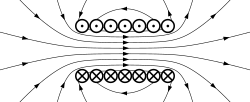
Back Електрет Bulgarian Elektret Czech Elektret German Electreto Spanish Elektreedid Estonian الکترت Persian Électret French Elektret Croatian Էլեկտրետներ Armenian Elettrete Italian
This article has multiple issues. Please help improve it or discuss these issues on the talk page. (Learn how and when to remove these messages)
|
| Articles about |
| Electromagnetism |
|---|
 |
An electret (formed as a portmanteau of electr- from "electricity" and -et from "magnet") is a dielectric material that has a quasi-permanent electrical polarisation. An electret has internal and external electric fields, and is the electrostatic equivalent of a permanent magnet.
The term electret was coined by Oliver Heaviside[1] for a (typically dielectric) material which has electrical charges of opposite sign at its extremities.[2] Some materials with electret properties were already known to science and had been studied since the early 1700s. One example is the electrophorus, a device consisting of a slab with electret properties and a separate metal plate. The electrophorus was originally invented by Johan Carl Wilcke in Sweden in 1762[3] and improved by Alessandro Volta in Italy in 1775.[4] The first documented case of production was by Mototarô Eguchi in 1925[5] who melting a suitable dielectric material such as a polymer or wax that contains polar molecules, and then allowing it to solidify in a powerful electric field. The polar molecules of the dielectric align themselves to the direction of the electric field, producing a dipole electret with a quasi-permanent polarization. Modern electrets are sometimes made by embedding excess charges into a highly insulating dielectric, e.g. using an electron beam, corona discharge, injection from an electron gun, electric breakdown across a gap, or a dielectric barrier.[6][7]
- ^ Heaviside, Oliver (1894). Electrical Papers. Macmillan and Company. pp. 488–493.
- ^ Gutmann, F. (1948). "The Electret". Reviews of Modern Physics. 20 (3): 457–472. Bibcode:1948RvMP...20..457G. doi:10.1103/RevModPhys.20.457. ISSN 0034-6861.
- ^ Vetenskapsakademien (Stockholm), Kungliga Svenska (1762). Kungliga Svenska Vetenskapsakademiens handlingar (in Swedish). Almqvist & Wiksell.
- ^ Pancaldi, Giuliano (2005). Volta: Science and Culture in the Age of Enlightenment. Princeton University Press. pp. Chapter 3. ISBN 978-0-691-12226-7.
- ^ Eguchi, Mototarô (1925). "XX. On the permanent electret". The London, Edinburgh, and Dublin Philosophical Magazine and Journal of Science. 49 (289): 178–192. doi:10.1080/14786442508634594. ISSN 1941-5982.
- ^ Gross, B. (1980), Sessler, Gerhard M. (ed.), "Radiation-induced charge storage and polarization effects", Electrets, Topics in Applied Physics, vol. 33, Berlin, Heidelberg: Springer Berlin Heidelberg, pp. 217–284, doi:10.1007/3540173358_12, ISBN 978-3-540-17335-9, retrieved 2024-01-22
- ^ Tsai, Peter P.; Schreuder-Gibson, Heidi; Gibson, Phillip (2002). "Different electrostatic methods for making electret filters". Journal of Electrostatics. 54 (3–4): 333–341. doi:10.1016/S0304-3886(01)00160-7.
© MMXXIII Rich X Search. We shall prevail. All rights reserved. Rich X Search